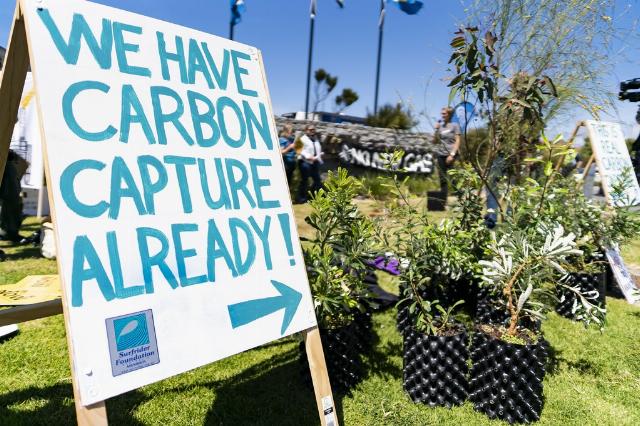
I’ve been hearing a lot of commercials on my favorite local conservative radio station from BP about their Carbon Capture and Storage (CCS) projects (CCUS for “underground” storage), so my natural curiosity got aroused and decided to investigate it.
The World Economic Forum reports: “While such technologies have been commercially available for decades, only 30 CCUS projects are currently in operation across the globe, according to the Global CCS Institute. Another 11 are in construction and 153 are in development (in 2022 alone, 61 new CCUS projects were initiated).”
What is CCS/CCUS? For now, these systems primarily operate on industries that emit CO2 as a byproduct of their operations. Per BP “CO2 is captured from various sources — either before it escapes into the atmosphere or directly from the air. The captured CO2 is compressed or liquefied and then transported, usually by pipeline. The CO2 is then safely stored permanently and securely thousands of feet underground — this process is often called “sequestration.””
Simple, right? Almost like that “clean” electricity that comes out of your wall plug to power those “clean” EV’s doesn’t come from coal or natural gas. Just don’t look behind the curtain and you’ll maintain your delusion of living in the magical land of Oz.
Let’s break down CCS:
CO2 is a gas (but you knew that), and makes up about 0.04% of the earth’s atmosphere. Oxygen comprises around 21%, with nitrogen, argon, and other random gasses making up most of the other 78%.
How do you “capture” CO2? Well, it’s not as easy as capturing the neighbor’s dog that got loose. One technique, called adsorption or absorption, “The emissions are piped into a device called an absorber, where the carbon dioxide interacts with chemical solvents that absorb it, allowing it to be separated from the other component gases, which are then released. The carbon dioxide and the solvent are then separated so the solvent can be reused.”
Is this process free? Nope. Requires energy.
Next is the process of compressing and liquifying the CO2. To turn into storable liquid, it must be compressed before it’s buried underground by geologic storage. In this method CO2 is liquified into “supercritical” carbon dioxide. As the U.S. Department of Energy explains, supercritical CO2 “has some properties like a gas and some properties like a liquid. In particular, it is dense like a liquid but has viscosity like a gas. The main advantage of storing CO2 in the supercritical condition is that the required storage volume is substantially less than if the CO2 were at ‘standard’ (room)-pressure conditions.”
<img alt captext="Matt Hrkac ” class=”post-image-right” src=”https://conservativenewsbriefing.com/wp-content/uploads/2024/04/another-climate-folly-carbon-capture-and-storage.jpg” width=”400″>What is the pressure of this compressed CO2? About 100 times atmospheric pressure (bars) or about 1,500 psi. That’s enough pressure to lift water 3,500 feet upward, or about 2/3 of a mile.
Is this process free? Nope. Requires energy.
The CO2 is then transported by truck or through pipelines to the storage site(s). Pipelines require pumps. Trucks typically require diesel fuel.
Is this process free? Nope. Requires energy.
Then the liquified CO2 is pushed down deep in the earth under layers of rock, which requires drilling and more pumping.
Is this process free? Nope. Requires energy.
So now that we’ve got liquified CO2 buried under a naturally porous earth at a pressure that can lift water the equivalent of the depth it is buried, how long will it stay there? Who knows? Even though there have been no long-term studies on this at the various geologic sites and conditions planned for these vast and expansive projects, various government-funded studies such as this one (laundered through MIT) are suggesting it’s “safe and effective” because gas has been found buried in the earth for millions of years. Spoiler alert… we didn’t put it there by drilling big holes. Big difference.
At least some are recognizing the burden CCS places on cost, energy, and effectiveness, but it doesn’t get much mainstream news. As this article in the MIT Technology Review put it, “The noise, news, and hype are feeding a perception that carbon removal will be cheap, simple, scalable, and reliable — none of which we can count on.” The WEF itself claims: “We identify three main challenges. The first is cost, as CCUS facilities are both capital-intensive to deploy and energy-intensive and expensive to operate… A second challenge is the underperformance (and sometimes outright failure) of CCUS operations, possibly due to their relative technological youth… Finally, CCUS operations are not free of environmental concerns. One risk is CO2 leakage from storage, though we can be reasonably reassured about the solidity of natural geological formations that have already stored gas for millions of years. CCUS systems increase environmental damages from toxicity, acidification, eutrophication, etc.”
Have no fear, however, because the U.S. Government is here to rescue this miserable technology. Per the WEF, the answer isn’t to just plant more trees… but keep throwing money at innovation! “We single out the US as a leader, with a recent $62 billion budget for the Department of Energy, including $10 billion earmarked for carbon capture, direct air capture and industrial emission reduction.”
Image: Matt Hrkac





